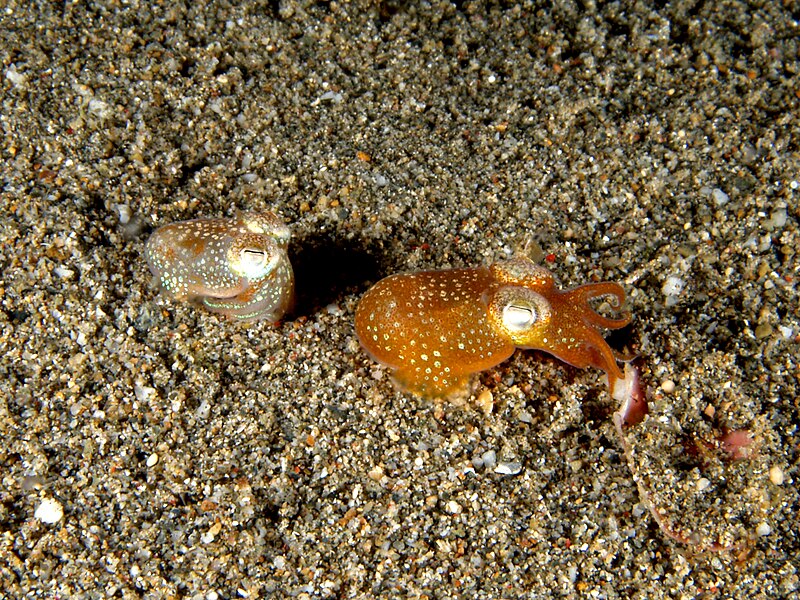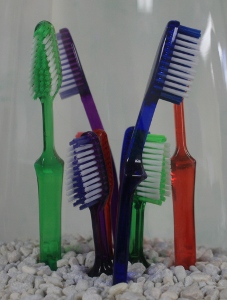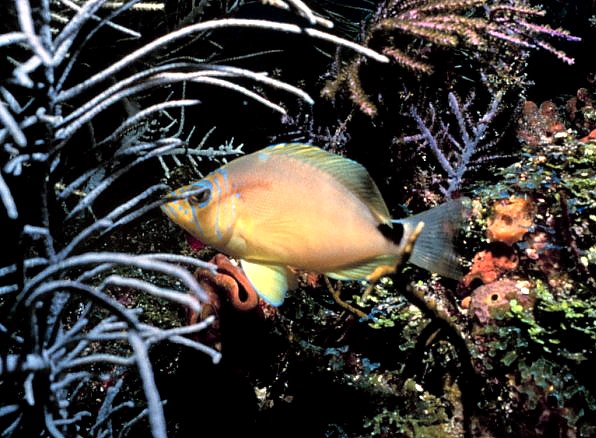 It’s no secret that cephalopods have amazing skill at camouflaging themselves to avoid predation. You may have seen the unique tactics of the mimic octopus in recent years, or you may have been lucky enough to see a squid or cuttlefish in action, changing color and skin texture with lightning-quick speed. Their abilities are intriguing to us and necessary for their survival in the big ocean blue. Read More »
It’s no secret that cephalopods have amazing skill at camouflaging themselves to avoid predation. You may have seen the unique tactics of the mimic octopus in recent years, or you may have been lucky enough to see a squid or cuttlefish in action, changing color and skin texture with lightning-quick speed. Their abilities are intriguing to us and necessary for their survival in the big ocean blue. Read More »
Author Archives: Eileen Daub
Feed SubscriptionA DIY Project – The Toothbrush Ornament

Supplies:
- Aquarium Sealant
- Hot Glue Gun
- 8 Acrylic Toothbrushes (soft bristle)
- Glass candle plate
- Dremel Saw
Pure Confusion – Finding the “Right” Water for Your Aquarium
 One common question that we receive about setting up new aquariums is about the most basic ingredient to the aquarium, the water that goes into it. There are a lot of terms that can get confusing when someone is trying to determine how to fill their aquarium and from what source. The options can be staggering – tap water, bottled water, prefilters, and so on – and starting with the right foundation can make all the difference, from the smallest betta bowl to the largest reef system.
One common question that we receive about setting up new aquariums is about the most basic ingredient to the aquarium, the water that goes into it. There are a lot of terms that can get confusing when someone is trying to determine how to fill their aquarium and from what source. The options can be staggering – tap water, bottled water, prefilters, and so on – and starting with the right foundation can make all the difference, from the smallest betta bowl to the largest reef system.
Tap Water
This is probably the easiest and most accessible water source in most areas. Whether you get your water from a municipal water sources or from a well, it doesn’t get much easier than going to the nearest sink to fill your bucket or tank. Its ease is definitely a benefit, but keep in mind that municipal water sources will usually contain chlorine or chloramine to kill bacteria and well water sources may contain phosphates or other organics. Tap water can be used, but should be treated or purified to remove these materials before it goes into your aquarium. Read More »
Role Reversal – Gender Switching in Saltwater Fish
 In our modern society, boys and girls are raised to be men and women and play equal roles in everything from defense to child-rearing. The animals kingdom isn’t as simple. With some animals, males and females have specific roles to play in their community and are nurtured for their positions. Many of the fish we keep in our aquariums have very different strategies. Weighing the balance between reproducing and surviving plays a huge part in their life history, right down to the most fundamental concepts of gender, size, and appearance.
In our modern society, boys and girls are raised to be men and women and play equal roles in everything from defense to child-rearing. The animals kingdom isn’t as simple. With some animals, males and females have specific roles to play in their community and are nurtured for their positions. Many of the fish we keep in our aquariums have very different strategies. Weighing the balance between reproducing and surviving plays a huge part in their life history, right down to the most fundamental concepts of gender, size, and appearance.
A “hermaphrodite” is an organism that has both male and female reproductive abilities. While this is usually very rare in animals like birds and mammals, it is extremely common in plants and some invertebrates. Biologically speaking, if the chances of a plant or animal running across another of its kind are low, the chances of it finding another with the opposite sex as itself that it can reproduce with are even lower. Therefore, not having an assigned gender or being able to act as both genders can be beneficial. Many plants, animals and invertebrates use this strategy, but we’ll focus on fish in this blog.
Fish like wrasses, parrotfish, anthias and clownfish use “sequential hermaphroditism”, meaning that instead of having both sets of reproductive organs, the fish starts out as one gender and at some point is triggered to switch to another. There are two types of sequential hermaphroditism that we can witness in the aquarium trade: protogyny and protandry. Read More »
Comparing Aquarium Testing Options
Many other blogs have discussed (and will continue to discuss, I’m sure) the importance of testing various levels in your water and its effects on the overall health of your aquarium. But, how can you actually test it? For anyone who isn’t able to bring a water sample into That Fish Place or their local fish store for testing or who wants monitor their water quality at home, there are lots of options for what tests to use. While what to actually test for is for another blog, there are lots of options when it comes to how the tests are actually done. Here we’ll look at the pro’s and con’s of the three most common aquarium testing methods: Test Strips, Liquid Test Kits, and Electronic Testing Equipment. Read More »
 That Fish Blog – Aquarium Advice and Information
That Fish Blog – Aquarium Advice and Information
